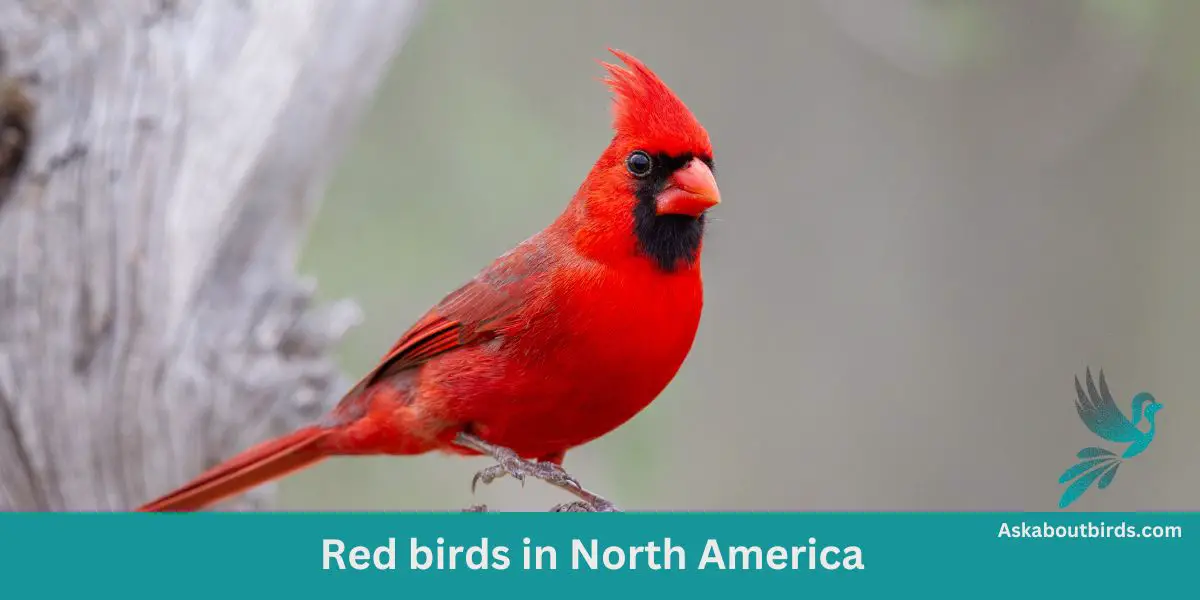North America, with its diverse habitats ranging from the dense woodlands of the east to the open plains of the west, boasts a vibrant array of bird species. Among these, the red birds stand out with a striking vibrancy, captivating bird enthusiasts and casual observers alike.
This guide dives into the most illustrious red-feathered residents of North America.
Key Takeaways:
- Diverse Habitats, Diverse Birds: North America’s varied landscapes host a range of red bird species.
- Not Just Cardinals: While the Northern Cardinal is a popular red bird, there are several others like the Summer Tanager and Western Tanager that are equally captivating.
- Significance of Red: Beyond aesthetics, the color red in birds often plays crucial roles in mating displays and territorial behaviors.
- Conservation is Key: Some red bird species face habitat challenges, making conservation efforts vital to their survival.
- Red Birds in Culture: These birds, with their vibrant hues, hold significant cultural and symbolic meanings in various Native American tribes and contemporary cultures.
List of Red Birds in US
House Finch


| Feature | Measurement |
|---|---|
| Scientific Name | Haemorhous mexicanus |
| Length | 5–6 in |
| Wingspan | 8–10 in |
| Weight | 0.6–0.9 oz |
The House Finch is a small songbird widely distributed across North America and is commonly found in urban and suburban areas.
Appearance: Males of this species are brightly colored with crimson faces and throats, which can extend to the chest and back, while their flanks have streaks. The female is streaked brown and lacks the red coloring. Both have a square-tipped tail and a distinctively long, flat-topped bill.
Diet: House Finches primarily eat seeds, grains, and berries. They have a particular fondness for sunflower seeds and can be commonly seen at bird feeders. Occasionally, they will also consume insects, especially during the breeding season.
Reproduction: House Finches are cavity-nesters and might choose ledges, vents, ledges, and other urban settings. They might also utilize trees or shrubs. Their nests can be made of a wide array of materials, from feathers to twigs.
Red-Tailed Hawk

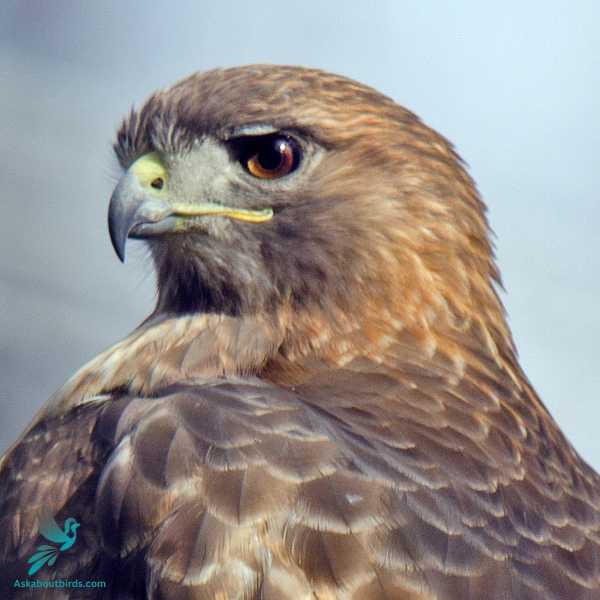
| Feature | Measurement |
|---|---|
| Scientific Name | Buteo jamaicensis |
| Length | 45–65 cm (18–26 in) |
| Wingspan | 110–141 cm (3 ft 7 in – 4 ft 8 in) |
| Weight | 690 to 1,600 g (1.5 to 3.5 lb) |
The Red-Tailed Hawk is a bird of prey that is commonly found across North America. This adaptable raptor is known for its brick-red tail, which is most noticeable in adults from above or underneath. The diet of the Red-Tailed Hawk is very diverse, including small mammals like mice and squirrels, as well as birds and reptiles.
This hawk is often seen perched on poles or soaring in wide circles high above fields, forests, and highways. Its habitat is extremely varied, ranging from desert and scrublands to forests and tropical rainforests. Its call, a raspy, screaming kee-eeeee-arr, is often used in movies to represent any bird of prey.
Red-breasted Sapsucker
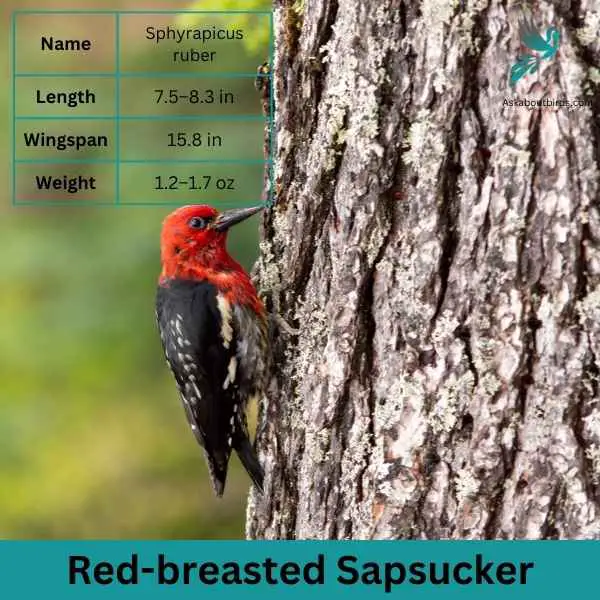
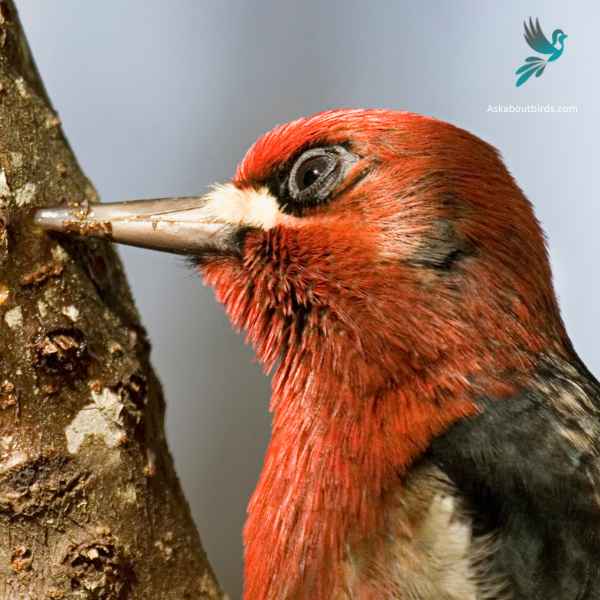
| Feature | Measurement |
|---|---|
| Scientific Name | Sphyrapicus ruber |
| Length | 7.5–8.3 in |
| Wingspan | 15.8 in |
| Weight | 1.2–1.7 oz |
The Red-breasted Sapsucker is a medium-sized woodpecker known for its vibrant coloration and distinctive foraging habits.
Appearance: This bird is primarily recognizable by its bright red head, breast, and flanks. The wings are black with white barring, and there’s a prominent white stripe running vertically down the wing. Its back is barred with black and white.
Diet: True to their name, Red-breasted Sapsuckers drill series of small holes in trees to feed on sap. They also consume insects attracted to this sap, as well as berries and fruits when available.
Reproduction: Red-breasted Sapsuckers create nest cavities in dead or decaying trees, and sometimes in living trees where the heartwood is decayed.
Red-headed Woodpecker

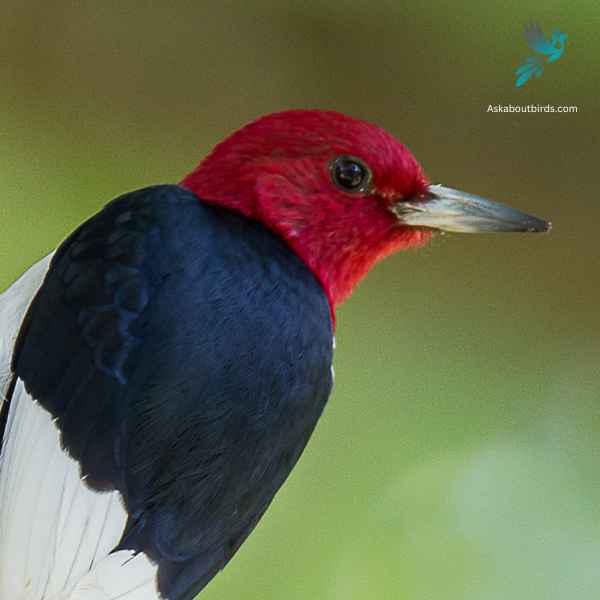
| Feature | Measurement |
|---|---|
| Scientific Name | Melanerpes erythrocephalus |
| Length | 7.5–9.1 in |
| Wingspan | 16.5 in |
| Weight | 2.0–3.2 oz |
The Red-headed Woodpecker is a striking forest bird with a bold tri-colored pattern.
Appearance: This woodpecker features a completely red head and neck, contrasting starkly with its white underparts and black wings. Its wings also have large white patches which are conspicuous in flight.
Diet: Red-headed Woodpeckers have a varied diet including insects, seeds, fruits, berries, and occasionally even the eggs of other birds. They’re also known to store food by wedging it into crevices in bark.
Reproduction: These woodpeckers nest in cavities which they excavate in dead wood or dead parts of live trees. These cavities can be found anywhere from 2 to 80 feet off the ground.
Scarlet Tanager


| Feature | Measurement |
|---|---|
| Scientific Name | Piranga olivacea |
| Length | 6.3 to 7.5 in |
| Wingspan | 9.8 to 11.8 in |
| Weight | 23.5 to 38 g |
The Scarlet Tanager is a strikingly colorful bird known for its brilliant plumage and distinctive song.
Appearance: Male Scarlet Tanagers are notable for their vibrant scarlet bodies contrasted with black wings and tail, making them one of the most intensely colored birds. Females and juveniles, on the other hand, have a subdued olive-yellow body color with darker wings and tail.
Diet: The diet of the Scarlet Tanager is largely made up of insects, including beetles, cicadas, aphids, and others. They are adept flycatchers, seizing insects in mid-air or picking them off foliage. They also consume fruits and berries, especially during migration and in their winter habitats.
Reproduction: The female Scarlet Tanager builds a cup-shaped nest using twigs, rootlets, and grass, typically well-hidden in the dense foliage of trees. She lays 3 to 5 eggs and incubates them for about two weeks.
Northern Cardinal


| Feature | Measurement |
|---|---|
| Scientific Name | Cardinalis cardinalis |
| Length | 8.3 – 9.1 in |
| Wingspan | 9.8 – 12.2 in |
| Weight | 1.19 – 2.29 oz |
The Northern Cardinal is an iconic North American bird, easily recognized by its vibrant color and melodious song.
Appearance: Male Northern Cardinals are a brilliant scarlet red, while females display a more subdued reddish olive. Both sexes have a distinctive black ‘mask’ on their face around the bill and a pointed crest on their head. The bird’s beak is robust, cone-shaped, and bright orange in color.
Diet: Northern Cardinals are primarily granivorous, with a diet largely consisting of seeds and grains. They also eat fruits and insects. These birds typically feed off the ground and are frequent visitors to bird feeders.
Reproduction: Northern Cardinals are monogamous, and a pair will breed together for life. The female typically builds a well-hidden nest in a dense thicket or shrub. She lays 2-5 eggs per clutch, which she incubates for around two weeks.
Summer Tanager


| Feature | Measurement |
|---|---|
| Scientific Name | Piranga rubra |
| Length | 6.7 in |
| Wingspan | 28 to 30 cm |
| Weight | 29 g |
The Summer Tanager is a medium-sized songbird admired for its radiant plumage and melodious song.
Appearance: Male Summer Tanagers are an impressive bright red, while females and juveniles present a softer, yellow-orange color. Both genders have a large, slightly hooked bill and relatively short tail.
Diet: Summer Tanagers primarily feed on insects, including bees and wasps, which they catch in flight or pick off vegetation. They are also known to eat fruits and berries, making them helpful in controlling pest populations and seed dispersal.
Reproduction: The female Summer Tanager builds a loose, shallow cup-shaped nest out of twigs and grass, usually hidden in the foliage of trees. The female typically lays 3-5 eggs, which she will incubate for about two weeks.
Western Tanager

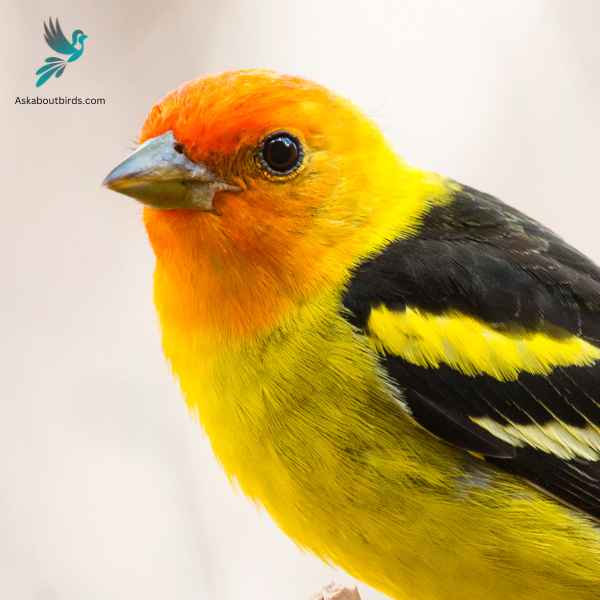
| Feature | Measurement |
|---|---|
| Scientific Name | Piranga ludoviciana |
| Length | 6.3-7.5 in |
| Wingspan | 11.5 in |
| Weight | 24-36 g |
The Western Tanager is a vibrant songbird that graces the forests and woodlands of the western regions of North America, enchanting observers with its colorful plumage and melodious song.
Appearance: The male Western Tanager is renowned for its bright yellow body contrasted with a striking red head and black wings and tail. The females are more subdued in hue, primarily being yellow with grayish wings and back, and lacking the brilliant red head of the males.
Diet: Western Tanagers primarily feed on insects, especially when breeding, but they also incorporate a significant amount of fruits and berries into their diet, especially during migration and winter.
Reproduction: Western Tanagers build their nests high in coniferous trees, often well concealed from potential predators. The female usually lays a clutch of 3 to 5 eggs and takes the primary role in incubation, while both parents are involved in feeding the chicks after they hatch.
Rufous Hummingbird


| Feature | Measurement |
|---|---|
| Scientific Name | Selasphorus rufus |
| Length | 3.1–3.9 in |
| Wingspan | 4.3 in |
| Weight | 0.1–0.2 oz |
The Rufous Hummingbird is a small, brilliantly colored bird known for its impressive migratory journeys and feisty behavior.
Appearance: The male Rufous Hummingbird boasts a gleaming orange-red body with a white chest and an iridescent red throat, called a gorget. The female has green upperparts with rufous-washed flanks and tail. Her throat may have some iridescent patches, but it’s generally whitish.
Diet: Like other hummingbirds, the Rufous Hummingbird primarily feeds on nectar from a variety of flowering plants. They also eat insects and spiders for protein, catching them in flight or plucking them from vegetation.
Reproduction: Rufous Hummingbirds nest in trees, shrubs, or even ferns. The female alone selects the site, builds the nest, and cares for the offspring.
Painted Bunting
Vermillion Flycatcher
Purple Finch


| Feature | Measurement |
|---|---|
| Scientific Name | Haemorhous purpureus |
| Length | 4.7–6.3 in |
| Wingspan | 4.7–6.3 in |
| Weight | 0.6–1.1 oz |
The Purple Finch is a vibrant songbird often mistaken for its close relative, the House Finch, but it exhibits a different hue and patterns.
Appearance: Males are raspberry red on the head, throat, and breast, with streaky brown backs and wings. The intensity of the red can vary among individuals. Females are brown and streaked all over but might show a slight blush on the face. They lack the strong facial patterns seen in female House Finches.
Diet: Purple Finches primarily consume seeds, with a preference for sunflower seeds, dandelion seeds, and buds. They also eat insects and berries, especially during the breeding season.
Reproduction: These finches often nest in conifers or mixed woodlands. The nest, typically located on a horizontal branch, is made from twigs and grass, then lined with feathers.
Common Redpoll

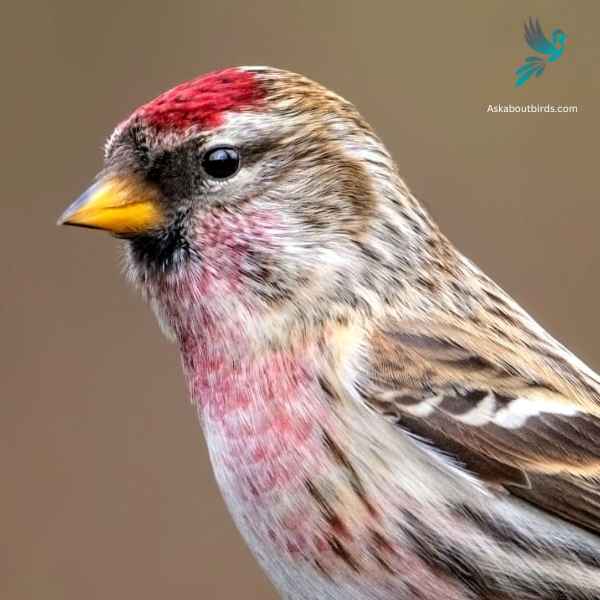
| Feature | Measurement |
|---|---|
| Scientific Name | Acanthis flammea |
| Length | 5.0-5.5 in |
| Wingspan | 7.5-8.5 in |
| Weight | 0.4-0.9 oz |
The Common Redpoll is a small songbird that is easily identifiable by its rosy-red forehead, black chin, and often fluttering flight pattern.
Appearance: Common Redpolls exhibit a distinctive rosy-red forehead patch and black chin. The males typically have a more extensive pink wash on their chest and face than females. The rest of their body is primarily streaked brown and white, with two white wing bars and a notched tail.
Diet: The diet of the Common Redpoll predominantly consists of seeds, particularly from birches and alders. They have a specialized throat pouch where they can temporarily store seeds, allowing them to consume them later in a more sheltered location.
Reproduction: Common Redpolls nest in shrubs or on the ground, using grasses, twigs, and feathers for construction. The female is responsible for the majority of the incubation and typically lays a clutch of 4 to 6 eggs. After the eggs hatch, both parents take part in feeding the young.
Rose-breasted Grosbeak
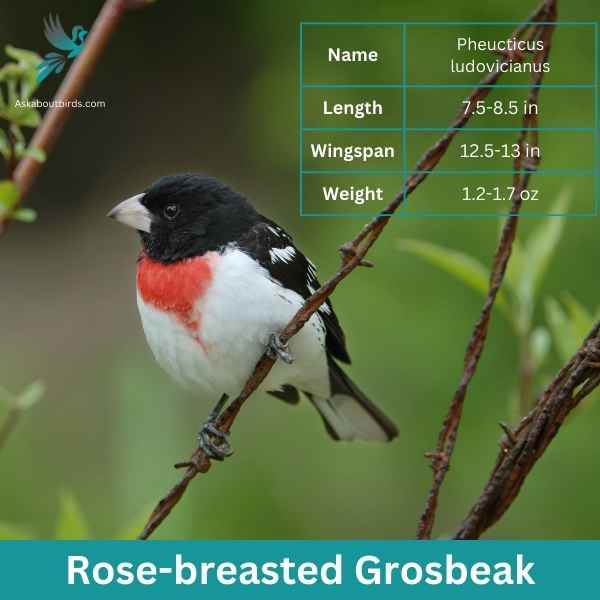

| Feature | Measurement |
|---|---|
| Scientific Name | Pheucticus ludovicianus |
| Length | 7.5-8.5 in |
| Wingspan | 12.5-13 in |
| Weight | 1.2-1.7 oz |
The Rose-breasted Grosbeak is a songbird of medium size, widely recognized for its vibrant coloration and melodious song.
Appearance: Male Rose-breasted Grosbeaks boast a striking contrast with black and white plumage accompanied by a radiant rose-colored patch on the chest and under the wings. In contrast, females exhibit streaked brown and white plumage, resembling large sparrows but with a thick bill.
Diet: The diet of the Rose-breasted Grosbeak consists of a mixture of seeds, insects, and fruits. During summer, they primarily feed on insects, while seeds and fruits become more prevalent in their diet during the colder months.
Reproduction: These birds build cup-shaped nests typically situated in trees or large shrubs. Both the male and female partake in incubation duties, ensuring the eggs’ safety and warmth. After hatching, the chicks are primarily fed insects.
Red Crossbill
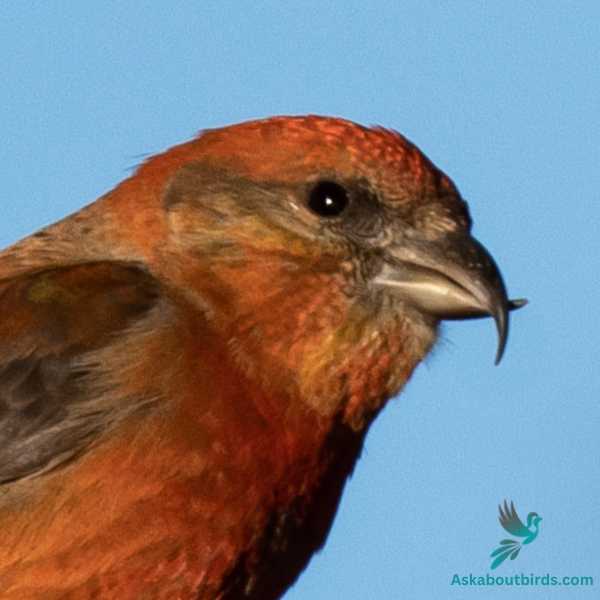

| Feature | Measurement |
|---|---|
| Scientific Name | Loxia curvirostra |
| Length | 20 cm |
| Wingspan | 27–29 cm |
| Weight | 40-53 g |
The Red Crossbill is a peculiar bird species, celebrated for its unique beak structure and vibrant coloration.
Appearance: Red Crossbills are named for their distinctive crossed mandibles, which are adapted to extracting seeds from conifer cones. Male Red Crossbills are usually bright red or orange, while females and juveniles are greenish-yellow. All have dark wings and notched tails.
Diet: The diet of the Red Crossbill is primarily composed of conifer seeds, their unique beak allowing them to access these seeds with ease. This diet includes seeds from pine, spruce, and other types of coniferous trees. They are also known to consume some insects.
Reproduction: Red Crossbills are known for their flexible breeding season, which can occur any time of the year when there is an abundance of food. They typically nest in conifers, where the female lays a clutch of 3 to 4 eggs.
Red-Crested Cardinal
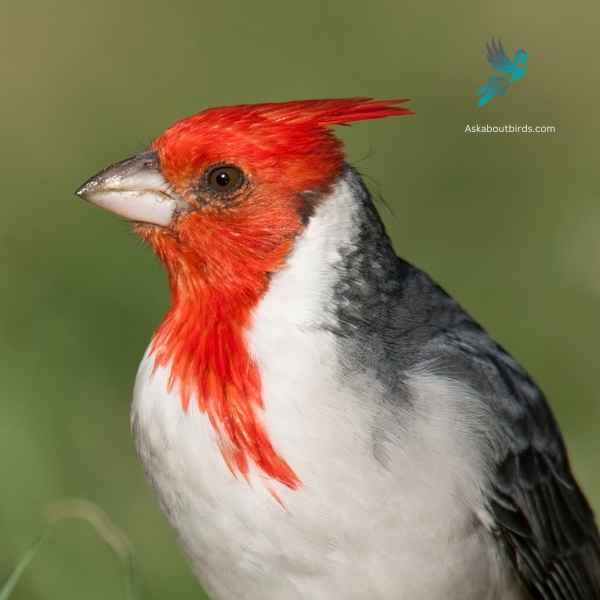
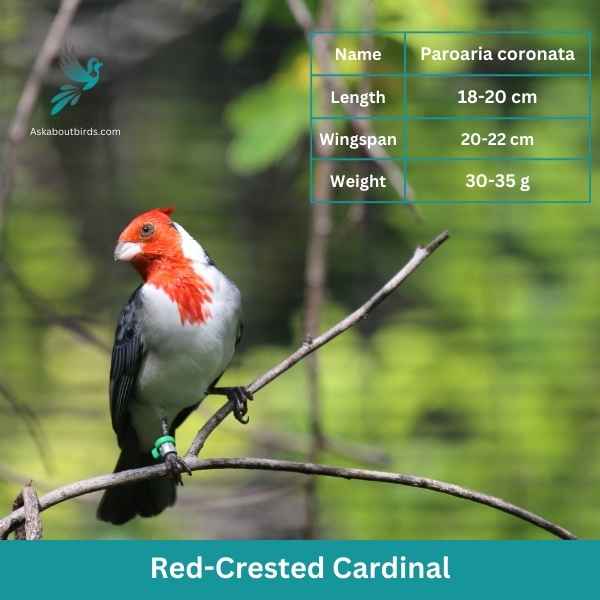
| Feature | Measurement |
|---|---|
| Scientific Name | Paroaria coronata |
| Length | 18-20 cm |
| Wingspan | 20-22 cm |
| Weight | 30-35 g |
The Red-Crested Cardinal is a visually striking bird native to South America, particularly found in countries like Brazil and Argentina. It is named for its vibrant red crest, which stands tall atop its head, contrasting with its grayish body and wings. Both males and females share this distinctive feature, with males having more pronounced red coloration.
These cardinals are typically found in open habitats such as grasslands, savannas, and gardens. They have adapted well to human-altered landscapes. Red-Crested Cardinals are omnivorous, feeding on a diverse diet that includes seeds, fruits, insects, and even small vertebrates. They use their powerful beaks to crack open seeds and capture prey.
Pine Grosbeak

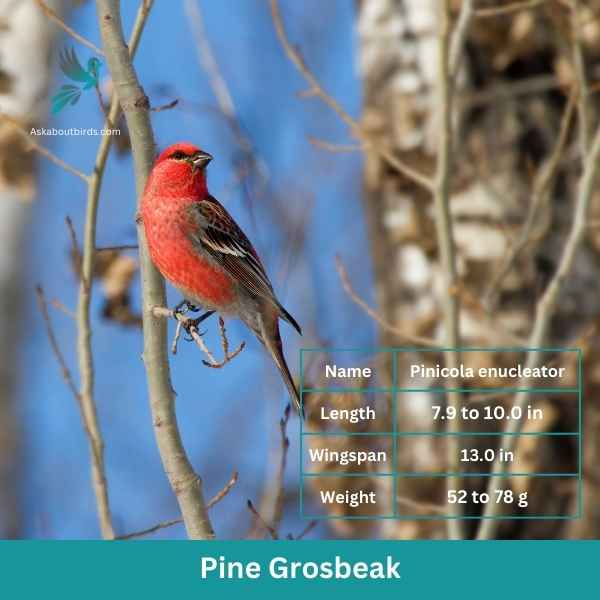
| Feature | Measurement |
|---|---|
| Scientific Name | Pinicola enucleator |
| Length | 7.9 to 10.0 in |
| Wingspan | 13.0 in |
| Weight | 52 to 78 g |
The Pine Grosbeak is a striking bird native to the northern regions of North America, often found in coniferous forests. Both males and females have a plump and robust body with a large beak adapted for eating seeds. The male Pine Grosbeak displays a vibrant reddish-pink plumage, while the female has a more subdued grayish-brown coloration.
These birds are typically seen in small flocks, foraging for food in trees and on the ground. They have a preference for seeds, particularly those from various conifer species. The Pine Grosbeak uses its strong bill to crack open the cones of tall trees and extract the seeds, but they also consume berries and small fruits when available.
Hepatic Tanager
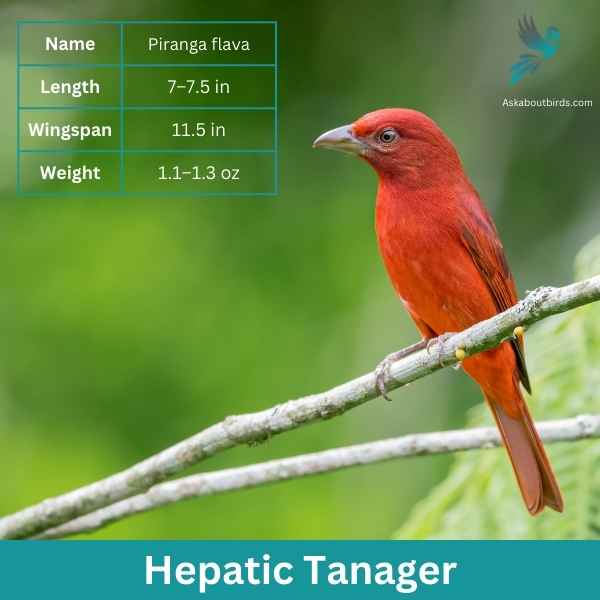
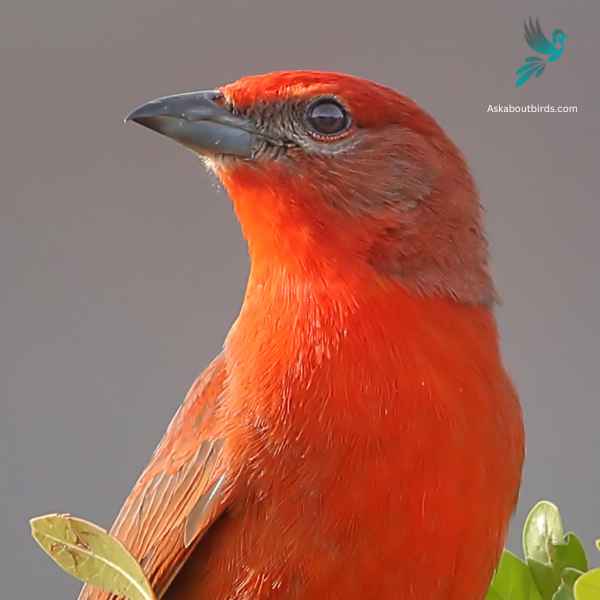
| Feature | Measurement |
|---|---|
| Scientific Name | Piranga flava |
| Length | 7–7.5 in |
| Wingspan | 11.5 in |
| Weight | 1.1–1.3 oz |
The Hepatic Tanager is a robust and brightly colored songbird found primarily in pine-oak woodlands of the American Southwest and Mexico.
Appearance: Male Hepatic Tanagers are a rich reddish-brown or “liver” color, from which they get their name (hepatic means liver-colored). Their wings and tail are more dusky, while females are a more muted yellow-orange, with a gray back and wings. Both sexes have a stout, pointed bill.
Diet: These tanagers primarily eat insects, but they also consume a fair amount of fruit and berries. They often forage by perching quietly and then making short flights to capture prey or pluck fruit.
Reproduction: Hepatic Tanagers nest in trees, often in a concealed location such as a dense clump of needles in a pine tree. The nest is a shallow cup made of twigs, grass, and pine needles. The female typically lays a clutch of 3 to 4 pale blue or greenish eggs. Both parents share feeding duties once the eggs hatch.
Red-faced Warbler
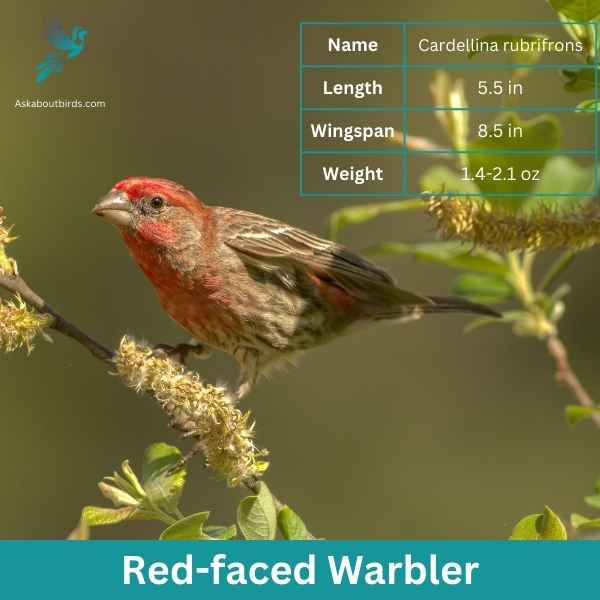

| Feature | Measurement |
|---|---|
| Scientific Name | Cardellina rubrifrons |
| Length | 5.5 in |
| Wingspan | 8.5 in |
| Weight | 1.4-2.1 oz |
The Red-faced Warbler is a vibrant and lively songbird recognized for its stark contrast between its bright red face and its cool-toned body.
Appearance: The Red-faced Warbler is characterized by its bright red face, extending from its forehead to its throat. Its crown and nape are black, creating a striking contrast. The rest of its body is predominantly gray with white undersides, and the birds have a pair of white wing bars.
Diet: This warbler mainly feeds on insects and spiders. They actively forage in the tree canopy and, on occasion, on the forest floor, picking off prey from leaves, twigs, and bark.
Reproduction: Red-faced Warblers nest on the ground, hidden beneath shrubs or other vegetation. The nests are crafted using grasses, pine needles, and other fine materials, and lined with feathers.
Roseate Spoonbill

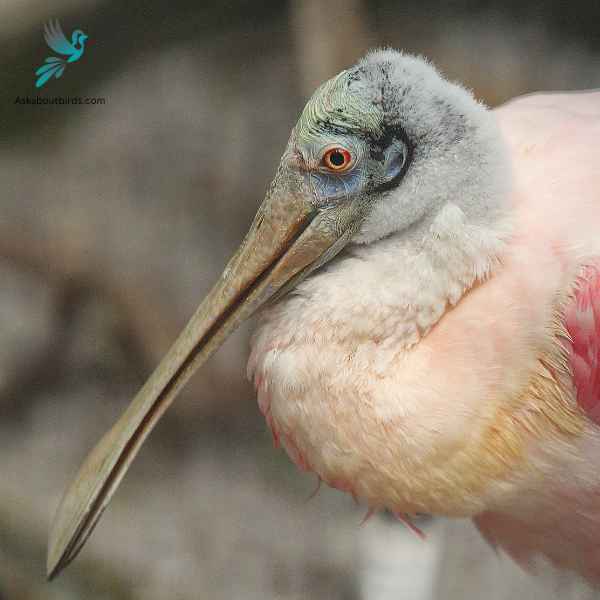
| Feature | Measurement |
|---|---|
| Scientific Name | Platalea ajaja |
| Length | 28–34 in |
| Wingspan | 47–52 in |
| Weight | 1.2–1.8 kg |
The Roseate Spoonbill (Platalea ajaja) is a large, long-legged wading bird known for its unique spoon-shaped bill and striking pink plumage, from which it derives its name.
The species’ eye-catching coloration ranges from light pink to bright magenta, accentuated by a patch of carmine red on the wing and a greenish tinge on the head and neck. The spoon-shaped bill, broad and flat at the end, is a highly specialized tool for feeding, allowing the bird to sweep through the water and scoop up small aquatic animals.
Residing in marshes, lagoons, and mangroves, the Roseate Spoonbill is found in the Americas, from the southern United States through Central America and into South America. They feed on crustaceans and other small aquatic animals, the carotenoid pigments of which contribute to their vibrant pink color.
American Robins


| Feature | Measurement |
|---|---|
| Scientific Name | Leptotila plumbeicep |
| Length | 10.6-11.8 in |
| Wingspan | — |
| Weight | 160-200 g |
The American Robin is a widely recognized bird species known for its melodious song and early bird tendencies.
Appearance: American Robins are medium-sized birds with a distinctive appearance. Both males and females sport a gray to brown back and a warm red to orange breast and belly and gray wings. They also have a characteristic white eye-ring and a black head, but males are usually darker than females.
Diet: American Robins have a diverse diet that changes depending on the season. In summer, they feed heavily on earthworms, beetles, and other invertebrates, which they catch on the ground. During winter, they mostly eat fruits and berries.
Reproduction: American Robins usually build their nests in trees or shrubs, but they are also known to nest on human-made structures. The female lays a clutch of about 3 to 5 eggs, which she incubates for about 12 to 14 days.
FAQS About US Birds That Are Red
Are there any red birds besides cardinals?
Yes, there are several red birds in North America besides the Northern Cardinal. The Scarlet Tanager is a strikingly bright red bird with black wings, often found in the eastern parts of the U.S. during the breeding season. The Summer Tanager, prevalent in the southeastern U.S., is another entirely red bird, often mistaken for the cardinal. The Red-winged Blackbird, while primarily black, has distinctive red patches on its shoulders. Furthermore, birds like the House Finch and the Purple Finch have reddish variations, and the Rose-breasted Grosbeak boasts a vibrant red chest. Each of these species adds a splash of red to North America’s avian landscape.
What is the red bird that is not a cardinal?
In North America, several birds sport a vivid red hue but aren’t cardinals. The Scarlet Tanager is a prime example, known for its brilliant red body contrasted with black wings, predominantly found in the eastern U.S. during the breeding season. Another entirely red bird is the Summer Tanager, which graces the southeastern parts of the country. The Rose-breasted Grosbeak, though not entirely red, showcases a striking red chest. These species, among others, ensure that bird enthusiasts have more to admire than just the iconic cardinal when seeking out red-feathered beauties in the wild.

